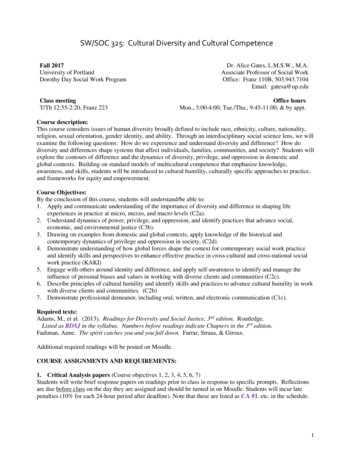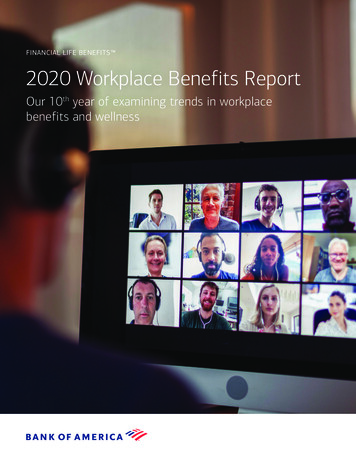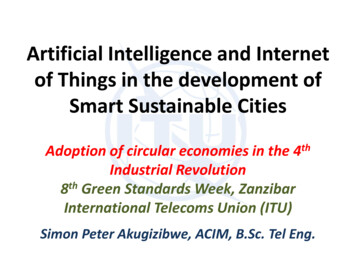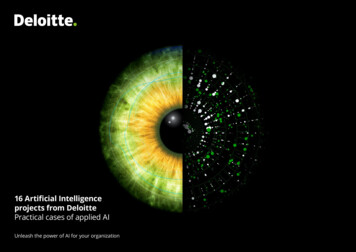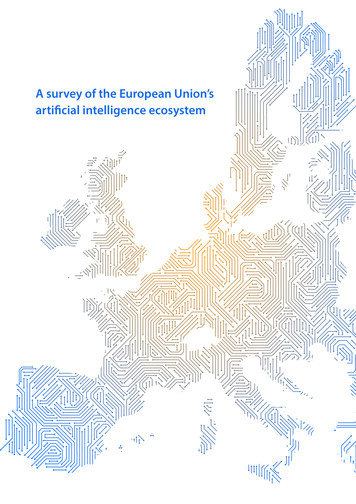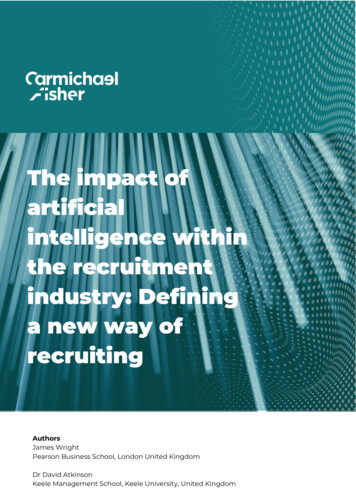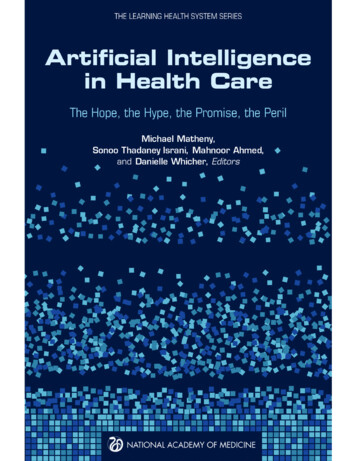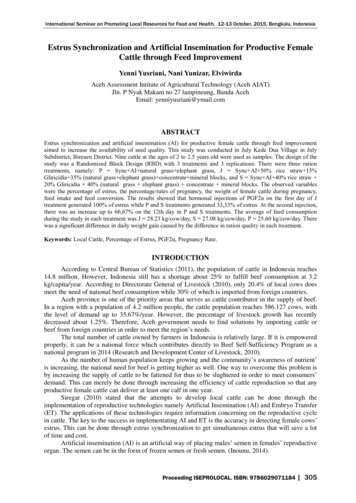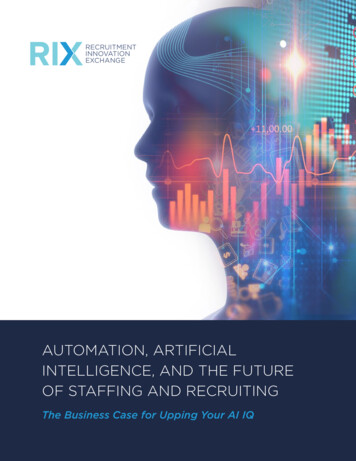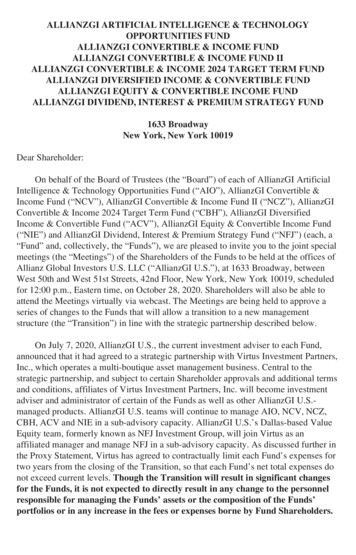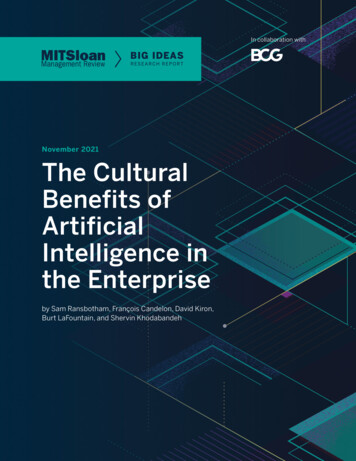
Transcription
In collaboration withNovember 2021The CulturalBenefits ofArtificialIntelligence inthe Enterpriseby Sam Ransbotham, François Candelon, David Kiron,Burt LaFountain, and Shervin Khodabandeh
AUTHORSSam Ransbotham is a professor in theinformation systems department at the CarrollSchool of Management at Boston College, aswell as guest editor for MIT Sloan ManagementReview’s Artificial Intelligence and BusinessStrategy Big Ideas initiative.François Candelon is a senior partner andmanaging director at BCG and the globaldirector of the BCG Henderson Institute. He canbe contacted at candelon.francois@bcg.com.Burt LaFountain is a partner and managingdirector at BCG and a core member ofBCG GAMMA. He can be reached atlafountain.burt@bcg.com.Shervin Khodabandeh is a senior partnerand managing director at BCG and thecoleader of BCG GAMMA (BCG’s AI practice)in North America. He can be contacted atshervin@bcg.com.David Kiron is the editorial director of MITSloan Management Review and is program leadfor its Future of the Workforce and ArtificialIntelligence and Business Strategy projects. Hecan be contacted at dkiron@mit.edu.SPECIAL CONTRIBUTORSMichael Chu, Matthieu Gombeaud, Su Min Ha, Allison Ryder, and Barbara SpindelCONTRIBUTORSSylvain Duranton, Todd Fitz, Carolyn Ann Geason-Beissel, Michele Lee DeFilippo, Janet Parkinson,Martin Reeves, Lauren Rosano, Lu Sun, and Rachel ZhaiThe research and analysis for this report was conducted under the direction of the authors as partof an MIT Sloan Management Review research initiative in collaboration with and sponsored byBoston Consulting Group.To cite this report, please use:S. Ransbotham, F. Candelon, D. Kiron, B. LaFountain, and S. Khodabandeh, “The Cultural Benefitsof Artificial Intelligence in the Enterprise,” MIT Sloan Management Review and Boston ConsultingGroup, November 2021.SUPPORTING SPONSORSCopyright Massachusetts Institute of Technology, 2021. All rights reserved.REPRINT NUMBER 63270
CONTENTS1Executive Summary3Introduction: Cultural Benefits of AI6Team-Level Cultural Benefits13Organization-Level Cultural Benefits17Conclusion
Executive SummaryThe benefits of artificial intelligence go well beyondimproved efficiency and decision-making. AI canalso improve organizational effectiveness andstrengthen teams and enterprise cultures.Artificial intelligence can generate cultural as well as financial benefits fororganizations. With AI systems in place, teams can perform tasks with morepride and confidence and collaborate more effectively: They can actually getstronger. These cultural benefits can penetrate the foundation of businessoperations, improving assumptions that drive organizational behaviors andensuring the pursuit of smarter goals.When conducting our research, we heard story after story from executivesfamiliar with AI implementations in their organizations. The overarchingmessage was clear and backed up by survey data: Business culture affects AIdeployments, and AI deployments affect business culture.This MIT SMR-BCG report — based on a global survey of 2,197 managers andinterviews with 18 executives — identifies a wide range of AI-related culturalbenefits at both the team and organizational levels. Among survey respondentswith AI implementations that improved efficiency and decision-making, forexample, more than 75% also saw improvements in team morale, collaboration, and collective learning. Culture change from using AI transcends thelegitimate, but myopic, promise that AI will liberate workers from drudgery.These cultural changes are more than a side benefit. AI-related cultural andfinancial benefits build on each other. Survey respondents who saw significant financial benefits from their AI initiatives were 10 times more likely tochange how they measure success than those who saw no such benefits. Insome cases, AI helped leaders identify new performance drivers, which ledto new assumptions, objectives, measures, and patterns of behavior, alongwith new areas of accountability. AI also helped these organizations realignbehaviors and become more competitive.Building a culture that supports innovation with AI has an effect on competitiveness. Our research found that respondents who use AI primarily toexplore new ways of creating value are far more likely to improve their ability to compete with AI than those who use AI primarily to improve existingprocesses. Respondents who said they use AI primarily to explore were 2.7times more likely to agree that their company captures opportunities fromadjacent industries — because of AI — than respondents who use AI primarilyto improve existing processes.Whether it’s reconsidering business assumptions or empowering teams, managing relationships among culture, AI use, and organizational effectiveness iscritical to increasing AI’s value to an organization. This report offers a data-driven analysis of these relationships at both the team and organization levels.The Cultural Benefits of Artificial Intelligence in the Enterprise1
2MIT SLOAN MANAGEMENT REVIEW BCG
Introduction: Cultural Benefits of AIAI implementations that improve effectiveness often strengthen team andenterprise cultures. Executives intimately involved with developing and implementing AI solutions offered numerous examples of how artificial intelligence helped their organizations become more efficient and make betterdecisions. What’s more, their team cultures were changing in response tothese new levels of effectiveness; the cultural changes encompassed whatteams learned, how they learned, how they worked together, and, in someinstances, what they enjoyed about their work. Many teams that used AIbecame stronger teams.Pierre-Yves Calloc’h, chief digital officer at Pernod Ricard, the world’s second-largest seller of wine and spirits, offers a case in point. The companybegan using AI technology to optimize salespeople’s store visits. Historically,the sales staff had relied heavily on their own experience to decide whichstores to visit. The company expected that its new AI-based system of digitalassistants, which uses data to prioritize stores, would encounter resistance.However, salespeople embraced the technology, which augments rather thanreplaces their own knowledge.Calloc’h fostered trust in the system by involving recognized business expertsin the tool’s design and gathering extensive feedback from pilot users. Histeam ensured that the reasons for the AI system’s recommendations wereclear, and clearly communicated, to the salespeople. In addition, his analyticsteam used interviews with the business experts to explore unexpected insightsand feed those insights into the recommendation engine. That bolstered thetool’s credibility among the experts and improved the effectiveness of the toolitself. According to Calloc’h, salespeople told him, “There’s no way I’m goingback to my previous way of doing things. I trust that the system has beenlooking at a lot of options when recommending the 20 stores that I shouldvisit this week. I’ll add some because there is outside information that I haveand the tool doesn’t have.”The technology also provides employees with new recommendations thatstrengthen their sales pitches. “The system is recommending listing onlyrelevant products matching the store profile, for instance, because of thecategory of consumers living around the store and other factors. That givessalespeople more confidence, more clarity, and higher morale,” says Calloc’h.Using AI not only directly improved efficiency and decision quality but indirectlychanged team culture through its effects on confidence, clarity, and morale.The Cultural Benefits of Artificial Intelligence in the Enterprise3
Our global survey attests that Pernod Ricard isn’t alonein experiencing AI’s effect on team culture: Many respondents who saw improvements in efficiency and decisionquality because of AI also saw team-level improvementsin morale (79%) and other cultural areas.ABOUT THE RESEARCHThis report presents findings from the fifth annualresearch effort between MIT Sloan Management Reviewand Boston Consulting Group on artificial intelligence and business strategy. In the spring of 2021, we fielded a global surveyand analyzed records from 2,197 total respondentsrepresenting 29 industries and 111 countries. We theninterviewed 18 executives researching or leading AI initiatives in large organizations in a broad range of industries,including financial services, media and entertainment,retail, travel and transportation, and life sciences. Ourresearch offers a detailed analysis of a dynamic betweenculture, AI use, and organizational effectiveness. In additionto our own field research, we used existing organizationalculture research to inform our use of the term “culture.”But AI’s effects on culture don’t stop at the team level.Our research further suggests that the cultural benefitsof AI adoption can extend to organizations as a whole.For example, we found that some executives employ AIto reassess strategic and operational assumptions. Increasingly, executives are recognizing that they can useAI to discern performance drivers that they themselvescannot identify through intuition and experience alone.Radha Subramanyam, president and chief research andanalytics officer at CBS, describes the broadcast network’sefforts to critically assess long-standing organizationalassumptions about how it measures the success of TVshows. “I gave our AI teams 50 years of KPIs [key performance indicators] and 50 years of consumer research,”she recalls. “I said, ‘Here are the things that we believeare important in this consumer research — quantitativeand qualitative. I’m giving you all the raw data. Are thethings that I habitually look at the right KPIs to drive mymega-KPI, or are they wrong?’”The analysis affirmed the utility of two historical KPIsbut also added two new KPIs to the set. “We got betterby going through this AI exercise,” Subramanyam noted. “The analysis changed what we were looking for andhelped improve our performance.” For CBS, AI providedboth the opportunity and the means for reexaminingfundamental assumptions about business operationsand organizational effectiveness. The assumptions thatguide team behaviors and enterprise goals are centralto organizational culture.1Revising organizational assumptions and measurementsis fairly typical of organizations that adopt AI: 64% ofcompanies that have integrated AI into their processessay that their use of AI led to changes in their KPIs. Insome cases, AI solutions directly reveal new performancedrivers, as at CBS, where they led to new KPIs. In othercases, using AI enables stronger performance, whichobsolesces legacy measurements that no longer reflectdesired goals. Realigning behaviors to achieve new objectives often has a direct effect on culture.4MIT SLOAN MANAGEMENT REVIEW BCG
VCULTUREOVIMPRPRIMOEEEFFECTIVE N ESSAI USEFIGURE 1The Culture-Use-Effectiveness DynamicImproving each component of the C-U-E dynamic canlead to a virtuous cycle of cultural improvement.IMPROVEOur research identifies a continuous dynamic amongculture, AI use, and organizational effectiveness. (seefigure 1.) We use this Culture-Use-Effectiveness (C-U-E)dynamic to explain mutually reinforcing relationshipsat both the team and organization levels. These relationships offer a useful perspective on how AI adoption caninfluence managerial assumptions, team behaviors, andoverall organizational competitiveness.The C-U-E dynamic is difficult to achieve at scale. Executives need to learn what AI can do for teams and theorganization, and develop a common language for decision-making with AI. Managers need to elicit active supportfrom employees who must work with AI solutions thatreplace or augment existing practices. After AI solutions’initial implementation, organizations must continuouslyadapt them, which requires ongoing participation fromAI teams and end users. Once AI solutions prove to beeffective, the resulting cultural and productivity benefitsencourage even more AI use throughout the enterprise.AI that is effective at the team level, however, doesn’talways yield financial success at the organization level.Only 11% of organizations in our survey attributed substantial financial benefits to their AI initiatives, which isthe same result we obtained from our survey last year.2 Itmay be that few companies are implementing AI at a scalesufficient to generate “substantial” financial benefits. Butanother possible explanation is that those organizationsthat obtain substantial financial benefits have begun tomaster the C-U-E dynamic. They learned both how toculturally adopt and benefit from AI, and how to use AIto glean financial rewards. Our research suggests thatthese are connected, not separate, activities.The Cultural Benefits of Artificial Intelligence in the Enterprise5
Team-Level Cultural Benefitscultivate team acceptance of AI, such as by includingAI-based solutions that generate new ways of workingendusers in the development process, building trust incan incite resistance from teams entrenched in existingAI system performance, and encouraging teams to becultures. Anju Gupta, vice president of data science andopen to changing their work processes. (see the sidebaranalytics at Northwestern Mutual, acknowledges that when“building trust to cultivate ai benefits,” page 7.)companies introduce new AI initiatives, “there is thisnatural resistance that you’ll bump up against.” CultureOur findings also distinguish the culture change reis like a team’s immune system: It is for the group whatF I G U R Eto2adopt AI from cultural changes that emergequireddefense mechanisms are for the individual.3 Our researchafter adopting AI. Figure 2 shows the C-U-E dynamic atTeam toCulture-Use-Effectiveness Dynamicindicates that managers often recognize Thethe needthe team level: Team culture can improve AI adoption,As AI helps improve whichefficiencyand improvesdecision quality,in turnteam effectiveness, which in turnteam culturebenefits.improvesteam culture. Learning is a key component ofeach element in the dynamic.FIGURE 2The Team Culture-Use-EffectivenessDynamicAs AI helps improve efficiency and decision quality, team culture benefits.TrustECollective learningT EA MCU L T U REClarity of rolesCollaborationOVIMPRPRIMOVUnderstandingEEF F ECT IV EN ESSAI USEIMPROVEEfficiencyDecision quality6MIT SLOAN MANAGEMENT REVIEW BCGMorale
BUILDING TRUST TO CULTIVATEAI BENEFITSdevelop shoulder to shoulder with the people who areactually going to use these things, up to the customer,”he explained. “If it impacts a customer, you develop italso with customers. If it impacts a planner, you developBoth financial and nonfinancial benefits from AI dependit with planners and you explain it to them, even up toon employees working with and trusting AI. Yet our surveythe point that you say, ‘Hey, we don’t know the price ofrespondents described numerous reasons why end usersthis, but we’re going to put an amount of 200 euros asmay mistrust AI solutions. (SEE FIGURE 3.)a proxy. Do you agree that we put in 200 euros? As theClose to half the respondents believed that mistrustgate agents, you are better positioned to decide this.’”of AI stemmed from a lack of understanding (49%) orStomph believes that a high level of involvement leadstraining (46%). Paul Pallath, global technology head ofto a view of AI as “a trusted colleague.” In his words, thedata, analytics, and AI at Levi Strauss&UCo.,thatFIGR E said3technology “becomes more than just a vague tool andthe company invested widely to improve understanding;really more of somebody that you can trust and rely on.”AdoptionDepends on Trustit selected employees “from variousAIdifferentdomains,Stomph sees the temptation to “dumb it down” and simplyfrom the retail store to people in IT to people in business,show users the end result in a flashy package. But heunderstanding and training areand called them into an eight-week,Insufficienthighly immersivesays that KLM works “to be genuine and connect withAI/ML boot camp.” The first cohort, whichgraduatedinthe greatestobstaclestobuildingtrustsurein AI.people,to makethat they really like these solutionsMay 2021, consisted of more than 40 employees from 14because of the content and not because of the package.”locations around the world. Pallath believes the investStill, no amount of user education can overcome a poorment was worth it because “they need to have trust. Andtool.Data of insufficient quality (31%), failure to meetbuilding trust in AI/ML and machinesUnderstandingcan only happen if andTrainingexpectations (20%), or just incorrect solutions (14%) allpeople themselves are part of the process rather thancan contribute to mistrust in the system. Colin Lenaghan,being subjected to it.”senior vice president of global net revenue managementBut the amount of user involvement isn’t an easy decision.at PepsiCo, recognizes how small improvements can addToo little context behind decisions (34%) or, conversely,up. PepsiCo believes that working to “prove stuff out andtoo much information (17%) can erode trust. Sandervery overtly socializing” cumulatively “builds confidence,Stomph, former head of operational excellence at Dutchbuilds trust, and helps you to move from one step to theairline KLM, recognizes that tension in working with AInext.” Lenaghan describes how the early “capabilitiessolution users. “What we did the past couple of years isimmediately inspired trust and credibility” among thosewho used PepsiCo’s AI-based promotional optimization50%46%tool. “That’s a really important process for us, becauseyou’re starting small, you’re building confidence. And IFIGURE 3InsufficientInsufficientFIGURE 3think that’s going to be important, because if you reallytraining (end usersunderstandingAI Adoption Depends on Trustof the AI solution and/or executives)AI Adoption Depends on Trusttook on quite a large, big-bang approach with this thing,(e.g., data used,Insufficient understanding and training are the greatestKPIs targeted)I just think it’s overwhelming.”obstacles to building trust in AI.Insufficient understanding and training arethe greatest obstacles to building trust in AI.Understandingand TrainingUnderstanding and Training50%Insufficientunderstandingof the AI solution(e.g., data used,KPIs targeted)46%Insufficienttraining (end usersand/or executives)SystemDesignSystem DesignToo much or too little context34%AI solutionprovides toolittle contextbehinddecisionsData quality and performance concerns17%31%AI solutionprovides too muchinformation andoverwhelms usersQuality of datanot trustedby users20%14%AI solutionsPerformanceappear incorrectdoes not meetuser expectations(multi-select question; responses may exceed 100%)System DesignToo much or too little context(multi-select question;responsesmay ofexceed100%)The CulturalBenefitsArtificialIntelligence in the EnterpriseData quality and performance concerns7
FIGURE 4Improving Team Effectiveness WithAI Bolsters Team CultureAfter implementing AI solutions, teams report improvedcollective learning, clarity of roles, collaboration, and morale.FIGURE 4Effective Use of AI Changes Team CultureAfter implementing AI solutions, respondents report improved collective learning,clarity of roles, collaboration, and morale on their teams.58%agree teams saw improvementsin both efficiency and decisionquality since their teamsimplemented AI.87%Collectivelearning65%Clarityof roles78%Collaboration79%Morale17%said they have seen either noimpact or a decrease in efficiencyand decision quality since theirteams implemented AI.36%Collectivelearning8%Clarityof roles20%Collaboration21%Morale(percentage of respondents reporting improvement in both efficiency and decision quality or neither efficiency nor decision quality)(percentage of respondents reporting improvement)8MIT SLOAN MANAGEMENT REVIEW BCG
Certainly, culture influences AI adoption. This well-researched connection usually involves team memberslearning about, and coming to trust, AI outcomes. Inearlier research, we identified mutual learning as a valuable contributor to AI adoption and use.4Using AI can also improve team effectiveness. We focus onefficiency and decision quality as indicators of effectiveness.About 58% of all survey respondents who participated in anAI implementation agreed that their AI solutions improvedefficiency and decision-making at the team level. That is,adding AI to the team improved team effectiveness. Thesurvey findings reinforce what we heard in our executiveinterviews: Using AI can strengthen team performance.But, more importantly, cultural benefits emerge whenteams improve decision-making and efficiency with AI,and, transitively, these benefits would not have emergedif the team’s culture had not embraced the AI solutions inthe first place. When teams become efficient and makebetter decisions because of AI, several aspects of culturealso improve, including collective learning, collaboration,morale, and clarity of roles. Figure 4, page 8, shows theextent to which effective AI — when AI improves efficiencyand decision quality — affects these culture aspects atthe team level.Effective Use of AI ImprovesCollective LearningCulture reflects the accumulated learning that a givengroup acquires and passes on to newcomers.5 (see thesidebar “defining organizational culture” for detailson how we define culture.) Our survey results show that87% of teams that improved their efficiency and decisionquality with AI also improved their collective learning.AI implementations influence both what teams learn andhow learning occurs. French energy company Rexel, forexample, designed its Next Best Offer tool for vendors torecommend upselling or cross-selling to clients basedon their specific circumstances. The initial rollout of thetool had mixed success: Some vendors almost alwaysused the tool’s recommendations, while others seldomdid. The AI team working on the tool discovered that avendor’s tenure determined its use of the tool. Newcomers,who had few ideas about what to offer next, were gladto have it. Veterans didn’t need the tool’s advice, but itturned out that they were also glad to have it, albeit fora different reason than the newcomers.New vendors had been pressing the veterans with requests for advice and support. As the tool became moreeffective, they stopped doing so. According to NathalieWright, Rexel’s group digital and IT director and Nordicregion general manager, one veteran gave her this feedback on the tool: “I do not learn anything from it, but Iunderstand that if I say ‘yes’ or ‘no,’ ‘good’ or ‘not good,’then that will help new people to do the job, and theywill stop coming to me every time, asking me for advice.”Veterans seemed more invested in training the tool thanin training the newcomers. Eventually, Rexel began usingthe tool explicitly for vendor training (while preservingits use as a recommendation engine).DEFINING ORGANIZATIONAL CULTUREOrganizational culture exists on at least three levels: howthings are done in the organization, the espoused valuesthat drive and govern those behaviors, and assumptionsthat could explain discrepancies between behaviors andpublicly stated values.i A toxic culture, for example, mightreflect a large discrepancy between how things are doneand the values leaders publicly espouse. As former Stanford University professor Joanne Martin observes, “Only asmall part of an organization’s culture consists of issuesand perceptions that people see clearly and agree on.The rest is characterized by incompletely understoodconflicts between groups; inconsistencies between, forexample, what people say they value and what they do;ambiguities about what frequently used phrases and goalstatements actually mean; and irreconcilable paradoxesand contradictions.”iiAn organizational culture may include inconsistencies butreflect stability. MIT professor Edgar Schein contends, “Atotal organization can have a culture if it has been a stablegroup for some period of time, and every subgroup withinthat organization can have a culture of its own if it has itsown stable history.”iii In an organizational culture, groupslearn shared assumptions that inform behavior patternsthat are passed on to new group members. At one level,culture includes what is learned and assumptions aboutwhat is (and is to be) valued.The Cultural Benefits of Artificial Intelligence in the Enterprise9
The Rexel Next Best Offer example illustrates severalways in which learning strengthens AI adoption, teameffectiveness, and team culture. When newcomers usedthe AI recommendation engine, they made better decisions than they would have without its advice. Veteranteam members helped make the tool more useful byadding their accumulated knowledge to it; teaching thetool promoted a culture of AI use.Pharmacists who used the tool came to a new understanding of how to execute their role. They learned somethingabout themselves, their customers, and how to handlecustomer calls. Our survey findings show that this is acommon result of effective AI implementations. Amongthose who reported increases in efficiency and decisionquality from their AI implementations, 65% saw improvedclarity of roles.Effective Use of AI Clarifies ResponsibilitiesEffective Use of AI Affects CollaborationIn other situations, AI-derived knowledge even helps expertsimprove their skills. Slawek Kierner, senior vice president,enterprise data and analytics, at Humana, explains howpharmacists in the health care company’s call centersused AI to improve how they handle interactions withcustomers: “We started with this emotional AI — essentially a software piece that listens to the conversation ofour pharmacists at a call center. It picks up emotionalsignals in this conversation and then suggests what thepharmacist could do to provide a better experience forthe member.” Kierner notes that adopting this softwarerequired time, training, and confidence-building. Histeam subsequently “found a set of innovators and showedthat those that use it actually end up with more calls withsatisfied customers and a higher Net Promoter Score. That,of course, then results in better service and better care forthe member, which is the unifying force.” It took effortfor managers to overcome cultural barriers and cultivateAI use. By training users and engaging advocates, alongwith other means, Humana carefully avoided culturerejection that this new tool could have sparked.The increased efficiency and decision quality from AIimplementations frequently lead to improved collaboration. Among respondents who saw an increase inefficiency and decision quality from AI, 78% reportedimproved collaboration. Sander Stomph, former head ofoperational excellence at the Dutch airline KLM, offeredan example from the airline industry. When a passengerarrives at the airport but misses their flight, the airlinemust offload that person’s luggage from the airplane forcompliance and security reasons. This time-consumingrequirement often delays flights, creating work for employees and annoying customers. KLM uses AI to predictwhich passengers are most likely to put the airline in thatposition. Since their bags are more likely to get pulledfrom the plane, their luggage is loaded last, making iteasier to pull it from the cargo hold.KLM managers realized that they could make the unloading process even smoother by putting the same large redtag on the late-arriving luggage that they affix to VIPs’luggage, which is also loaded last. Stomph says, “Now,if you’re late or if we think that you’re going to show uplate, we’re going to give you a VIP luggage tag.”“It has been a huge benefit for us to see the teamsstarting to pick up valuable work that they, inessence, did not have the bandwidth for priorto the implementations that we’re releasing.”SIDNEY MADISON PRESCOTTGlobal head of intelligent automation, Spotify10MIT SLOAN MANAGEMENT REVIEW BCG
With an AI assist, KLM’s crew and maintenance teamsseamlessly work together to fulfill the common goal of anon-time departure. Pilots don’t have to delay departuresas often; flight attendants don’t have to pacify frustratedpassengers as often; and baggage handlers speedily andcomfortably unload only the necessary cargo. This prediction-based process helps align teams, enabling themto enjoy better coordination throughout the departureprocess. KLM’s ability to predict which bags will needto be offloaded during the departure process effectivelybecame learning which bags they will need to offload.These predictions or lessons learned led to better coordination among different groups and thus to moresatisfied customers.Overall, 59% of respondents directly involved in AI implementations reported improved team collaboration dueto their use of AI. That number increases to 78% amongthose respondents who also saw improvements in efficiency and decision quality after using AI. Amy Adams,senior director of global CRM and martech strategy atMcDonald’s, notes, “As we work to elevate McDonald’scustomer experience, we are using advanced analytics ina more advanced, agile way. This data allows us to betterunderstand customer needs and expectations, enablingus to deliver the most relevant experience. We’ve alsodeveloped a global test-and-learn practice that allows usto better anticipate what will resonate with customersby testing various hypotheses. We’ve been building thisnew way of working and muscle over the last few years,and this capability has really motivated and influencedthe organization to work cross-functionally in a differentway than we had ever done previously.”Effective Use of AI Improves MoraleAmong teams that improved their efficiency and decision quality with AI implementations, 79% reported anincrease in morale. For example, Swedish fast-fashionretailer H&M Group experimented with different waysof using AI to help price products for end-of-season sales.It tested scenarios in which h
of an MIT Sloan Management Review research initiative in collaboration with and sponsored by Boston Consulting Group. To cite this report, please use: S. Ransbotham, F. Candelon, D. Kiron, B. LaFountain, and S. Khodabandeh, “The Cultural Benefits of Artificial Intelligence in the Enterprise,” MIT Sloan
